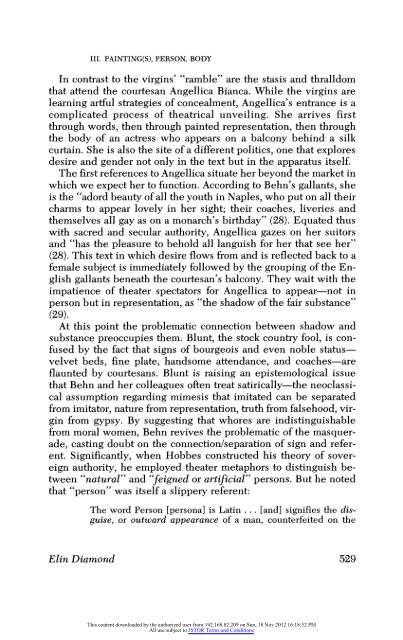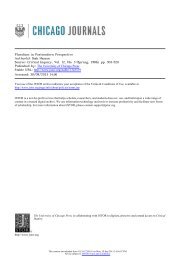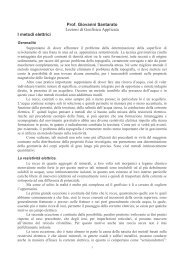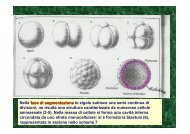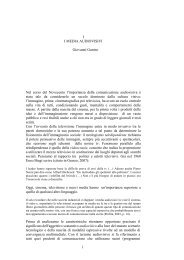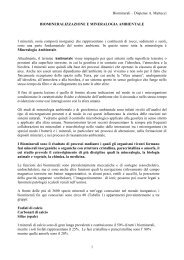Gestus and Signature in Aphra Behn's the Rover
Gestus and Signature in Aphra Behn's the Rover
Gestus and Signature in Aphra Behn's the Rover
Create successful ePaper yourself
Turn your PDF publications into a flip-book with our unique Google optimized e-Paper software.
III. PAINTING(S), PERSON, BODY<br />
In contrast to <strong>the</strong> virg<strong>in</strong>s' "ramble" are <strong>the</strong> stasis <strong>and</strong> thralldom<br />
that attend <strong>the</strong> courtesan Angellica Bianca. While <strong>the</strong> virg<strong>in</strong>s are<br />
learn<strong>in</strong>g artful strategies of concealment, Angellica's entrance is a<br />
complicated process of <strong>the</strong>atrical unveil<strong>in</strong>g. She arrives first<br />
through words, <strong>the</strong>n through pa<strong>in</strong>ted representation, <strong>the</strong>n through<br />
<strong>the</strong> body of an actress who appears on a balcony beh<strong>in</strong>d a silk<br />
curta<strong>in</strong>. She is also <strong>the</strong> site of a different politics, one that explores<br />
desire <strong>and</strong> gender not only <strong>in</strong> <strong>the</strong> text but <strong>in</strong> <strong>the</strong> apparatus itself.<br />
The first references to Angellica situate her beyond <strong>the</strong> market <strong>in</strong><br />
which we expect her to function. Accord<strong>in</strong>g to <strong>Behn's</strong> gallants, she<br />
is <strong>the</strong> "adord beauty of all <strong>the</strong> youth <strong>in</strong> Naples, who put on all <strong>the</strong>ir<br />
charms to appear lovely <strong>in</strong> her sight; <strong>the</strong>ir coaches, liveries <strong>and</strong><br />
<strong>the</strong>mselves all gay as on a monarch's birthday" (28). Equated thus<br />
with sacred <strong>and</strong> secular authority, Angellica gazes on her suitors<br />
<strong>and</strong> "has <strong>the</strong> pleasure to behold all languish for her that see her"<br />
(28). This text <strong>in</strong> which desire flows from <strong>and</strong> is reflected back to a<br />
female subject is immediately followed by <strong>the</strong> group<strong>in</strong>g of <strong>the</strong> English<br />
gallants beneath <strong>the</strong> courtesan's balcony. They wait with <strong>the</strong><br />
impatience of <strong>the</strong>ater spectators for Angellica to appear-not <strong>in</strong><br />
person but <strong>in</strong> representation, as "<strong>the</strong> shadow of <strong>the</strong> fair substance"<br />
(29).<br />
At this po<strong>in</strong>t <strong>the</strong> problematic connection between shadow <strong>and</strong><br />
substance preoccupies <strong>the</strong>m. Blunt, <strong>the</strong> stock country fool, is confused<br />
by <strong>the</strong> fact that signs of bourgeois <strong>and</strong> even noble statusvelvet<br />
beds, f<strong>in</strong>e plate, h<strong>and</strong>some attendance, <strong>and</strong> coaches-are<br />
flaunted by courtesans. Blunt is rais<strong>in</strong>g an epistemological issue<br />
that Behn <strong>and</strong> her colleagues often treat satirically-<strong>the</strong> neoclassical<br />
assumption regard<strong>in</strong>g mimesis that imitated can be separated<br />
from imitator, nature from representation, truth from falsehood, virg<strong>in</strong><br />
from gypsy. By suggest<strong>in</strong>g that whores are <strong>in</strong>dist<strong>in</strong>guishable<br />
from moral women, Behn revives <strong>the</strong> problematic of <strong>the</strong> masquerade,<br />
cast<strong>in</strong>g doubt on <strong>the</strong> connection/separation of sign <strong>and</strong> referent.<br />
Significantly, when Hobbes constructed his <strong>the</strong>ory of sovereign<br />
authority, he employed <strong>the</strong>ater metaphors to dist<strong>in</strong>guish between<br />
"natural" <strong>and</strong> "feigned or artificial" persons. But he noted<br />
that "person" was itself a slippery referent:<br />
The word Person [persona] is Lat<strong>in</strong> ... [<strong>and</strong>] signifies <strong>the</strong> disguise,<br />
or outward appearance of a man, counterfeited on <strong>the</strong><br />
El<strong>in</strong> Diamond 529<br />
This content downloaded by <strong>the</strong> authorized user from 192.168.82.209 on Sun, 18 Nov 2012 16:18:52 PM<br />
All use subject to JSTOR Terms <strong>and</strong> Conditions


